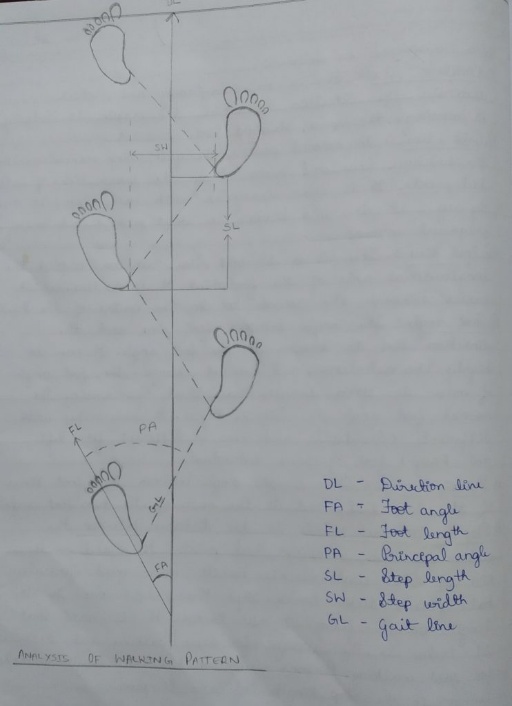
GAIT PATTERN EXAMINATION
- By Mr. Vincent Junior Ndlovu
This article is mainly about the use of the gait pattern examination in solving crimes. It helps investigators to be able to identify criminals from the way they walk and also from the footprints they leave behind after a criminal act.
The gait pattern examination is basically the method of analysing video footage of certain unknown individuals and trying to match them with known individuals taken on different days. The gait pattern examination can also be essential in determining the weight, stature and also sex of an individual. Human gait was first studied in the medical field to evaluate and determine if a patient has a disease or not. After a while researchers discovered that each individual has a distinct style of walking just like each person has a distinct fingerprint and iris and as a result it was recommended that it be used to identify individuals and it was an effective method since it can be done at a distance and it also does not require any of the user’s interaction. The human gait pattern mainly focuses on two categories namely model-based method and motion-based method. The model-based method aims at the description of human movement using mathematical models and motion-based sequence considers the human gait as a sequence of image and extracts certain features from the images. The gait pattern examination to be useful for any forensic science cases, the traits or features displayed by the criminals must follow certain principles which include universality and uniqueness. The identification of an individual using the gait pattern examination requires the investigators to take some features into consideration. Static measurements, dynamic measurements, spatial parameters, temporal parameters and angular displacement parameters must be considered.
Static measurements include geometrical measurements such as length of a leg and dynamic measurements involve the measurement of the length of a stride. Spatial parameters include the measurement of footprints in correspondence with a drawn progression imaginary line that follows the direction of walking. The parameters measured include step length and stride length. Temporal parameter focuses on the time taken for each stride and the angular displacement parameter focuses on angles produced by hips and knees when walking.
The gait pattern examination mainly focuses on the manner in which a suspect or individual walks and trying to match these features to those of an individual captured on CCTV footage during a criminal act. The first step in gait pattern examination is for the forensic experts to analyse and determine whether the video footage provided which shows a criminal walking is enough to perform a forensic gait analysis and that footprints left are visible enough. Gait pattern examination is conducted in two main ways which are analysing footprints left at a crime scene and also analysing a video of a person walking. For accurate analysis, footprints left at a crime scene must clearly show the dimensions of the footprints, their shape, margins and toe marks if the person was walking barefooted. For an accurate report based on gait pattern examination to be produced, the investigators must follow certain steps that include analysis, comparison, evaluation, verification and report. From this analysis, a profile of the person is produced and is compared against the profile of suspects and this evidence is often only permissible as supplementary evidence alongside other forms of evidence. The gait pattern examination assists in the investigation of crimes by analysing, comparing and evaluating features of gait. The gait pattern examination is viewed as a contributor to the process of identifying people from CCTV footage together with footprints. Footprints from crime scenes can be recovered in the form of bare prints, imprints and shoeprints and they can be recovered from criminal activities such as theft, housebreaking, murder, homicide and kidnapping. The use of footprints and gait pattern examination in forensic science all falls under a discipline known as forensic podiatry.
Forensic podiatry is defined as the application of sound and researched podiatric knowledge and experience in forensic investigations to show the association of an individual with a scene of crime or to answer any other legal question concerned with the foot or footwear that requires knowledge of the functioning foot (Krishan et al, 2015). A forensic podiatrist who is known for helping countries worldwide is Dr Nirenberg and he is a forensic gait expert. The expertise possessed by Dr Nirenberg in gait pattern examination can be used in forensic analysis to convict a criminal or exonerate an individual who has been wrongly accused by comparing features from the way they walk and run. The gait pattern examination can also be used to eliminate a person of interest. Dr Nirenberg with his expertise in gait pattern examination analyses the features portrayed by a criminal such as walking and running during a criminal act.
Dr Nirenberg expertise came to use when he helped to solve a robbery and also a murder case. On January 4, 2017 three men robbed a shop and from the video footage recovered, it showed the men wearing black from head to toe. The men did not leave anything for the investigators and the investigators only had a video footage of the men. There were no fingerprints, shoe prints or DNA which was left behind by the men. The investigators suddenly got a break on the case when they found that one of the men was particularly walking the same way as the man who had come in the store the previous day before the robbery took place. The investigators then sought for Dr Nirenberg’s expertise in gait pattern examination and he analysed the suspect’s movement from head to foot from the two video footages recovered and he found that every feature matched. The examination was presented as evidence in court and it paid off and the men were arrested.
The gait pattern examination was also presented as a form of evidence in the case of Thomas Jackson in 1893 who was identified from a video footage with walking with a limp.
https://legaldesire.com/importance-of-gait-pattern-in-person-identification/image-224598
The gait pattern examination of an individual is analysed using the following: direction line, gait line, foot line, foot angle, principal angle, step length and step width. The directional line is a straight imaginary line drawn at the centre to determine the direction the person was walking. The gait line coincides with the direction line and it varies from one individual to another because of the way one puts the foot down. The gait line for pregnant women appears broken as they walk with their feet wide apart. The foot line passes through the second toe to the centre of the heel and it shows the angle at which the foot is put down. The foot angle is the angle between the direction line and foot line and the normal foot angle varies between 30 to 32 degrees. It is different for the left and right foot of same individual. The principal angle is the angle between foot lines of two feet and it depends upon the deformities in the left or right foot of an individual. The step length is also known as a stride and it varies on the speed and habits of an individual. A tall person has a long stride than short person. The step width is the distance between parallels drawn in the direction of the direction line touching inner sides of right and left foot. All these are analysed in order to come up with profile of a possible criminal and are unique and vary from one individual to another. The use of gait pattern examination in solving crimes has encouraged more businesses to install video cameras for surveillance since many criminals may be seen on video footage walking or running.
The use of the gait pattern examination is easy as it can be done from a distance and also requires minimum or no interface at all from the user. The gait pattern examination has limitations and these can mislead detectives during analysis. Some of the factors that may limit the gait pattern examination include fatigue, sex, speed of walking, pregnancy, age, footwear, music, attire and also emotional state of mind. The other limitation which has led to the criticism of the gait pattern examination is the lack of a database which can be used to compare gait. Gait shows high intra-individual variability from person to person depending the emotional state of mind and occasion which makes it difficult to identify an individual. The experts are also not following any standard protocol for their analysis and as such there is variation on methodology used for analysis by different experts and this information creates confusion amongst the judges. The efficiency of the gait pattern examination can be enhanced by the use of all the types of video footages that can be acquired at the time of a criminal act such as phone recordings, traffic cameras and CCTV footages so as to get a broader analysis of an individual and to be able to come up with an accurate profile.
REFERENCES
Birch, I., Nirenberg, M. & Vernon, W., 2020. Forensic Gait Analysis: Principles and Practice.
DeLisa, J. A., 2000. Gait Analysis in the Science of Rehabilitation.
Kelly, H. D., 2020. Forensic Gait Analysis.
Patil, M., 2021. FUNDAMENTALS OF FORENSIC SCIENCE.
Whittle, M., 1991. Gait Analysis: An Introduction.
Written BY:
Mr. Vincent Junior Ndlovu [Intern ID:IP2305]
Undergraduate degree in Forensic Science
University of Zimbabwe
